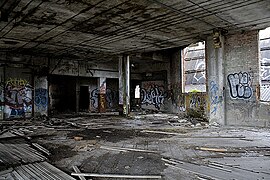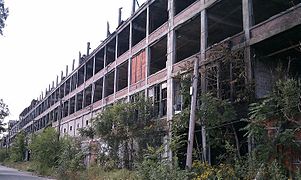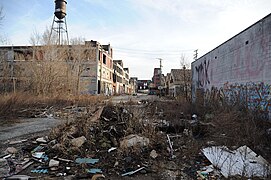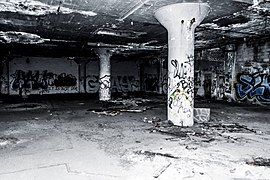Planta Automotriz Packard , la enciclopedia libre
| Planta Automotriz Packard | ||
|---|---|---|
| Packard Automotive Plant | ||
 | ||
| Localización | ||
| País | Estados Unidos | |
| Ubicación | Detroit, Míchigan | |
| Coordenadas | 42°22′47″N 83°01′44″O / 42.3796, -83.0289 | |
| Información general | ||
| Otros nombres | Packard Automotive Plant, Motor City Industrial Park, Packard Plant | |
| Usos | Fábrica | |
| Construcción | 1911 | |
| Diseño y construcción | ||
| Arquitecto | Albert Kahn Associates | |
La Planta Automotriz Packard (en inglés, Packard Automotive Plant) es una antigua fábrica de fabricación de automóviles en Detroit, la ciudad más poblada del estado de Míchigan (Estados Unidos). Packard Motor Car Company y más tarde Studebaker-Packard Corporation fabricaron allí automóviles de lujo. En la actualidad el edificio se encuentra abandonado, con zonas en ruinas.
Diseño y funcionamiento
[editar]Los años Packard
[editar]
El edificio de 325 000 m², diseñado por Albert Kahn Associates con productos de Trussed Concrete Steel Company, está ubicado en16 ha de terreno en East Grand Boulevard en el lado este de Detroit. Incluyó el primer uso de hormigón armado en los Estados Unidos para la construcción industrial en la industria del automóvil.[1][2][3][4][5]
La planta de Packard se inauguró en 1903 y tenía 929 m² de superficie útil y en ese momento se consideraba la instalación de fabricación de automóviles más moderna del mundo. Para 1908, cuando se anunció una ampliación para la construcción de camiones, la fábrica ya era seis veces más grande que cuando se construyó y ocupaba más de 5,6 ha de espacio.[6] En su apogeo, el complejo empleó a 40 000 personas, incluidos hábiles artesanos involucrados en más de 80 oficios. La planta produjo automóviles Packard desde 1903 hasta 1956, excepto durante la Segunda Guerra Mundial, cuando la producción se cambió a material de guerra, en particular el Packard V-1650 Merlin, que propulsó el avión de combate norteamericano P-51 Mustang.[7]
Algunas transmisiones de televisión experimentales se llevaron a cabo desde el edificio, incluida una producción condensada en 1939 de The Merry Widow, con una Betty White adolescente.[8]
Después de Packard
[editar]El complejo de la fábrica cerró en 1958, aunque otras empresas operaron en las instalaciones o las utilizaron para almacenamiento hasta fines de los años 1990.
En la década de 1990, los edificios se utilizaron para albergar raves y fiestas tecno "underground", incluida la fiesta Spastik organizada por Richie Hawtin[9][10]
Varios de los edificios exteriores estuvieron en uso por empresas hasta principios de los años 2000. En 2010, el último inquilino restante, Chemical Processing, anunció su intención de desocupar las instalaciones después de 52 años.[11]
Estado actual
[editar]Desde su abandono, la planta ha sido un refugio para grafiteros, exploradores urbanos, aficionados al paintball y desguazadores de automóviles, y gran parte del cableado y otros materiales de construcción han sido retirados del sitio.[12][13]
A pesar de muchos años de abandono y abuso, las estructuras de hormigón armado permanecen casi intactas y estructuralmente sólidas. Partes de los pisos superiores de varias secciones pequeñas en varios edificios se han derrumbado o han sido parcialmente demolidas y yacen en ruinas a raíz de varios intentos fallidos de demolición a lo largo de los años. La ciudad de Detroit se comprometió a emprender acciones legales para demoler o asegurar la propiedad.[14]
El 23 de enero de 2019 se derrumbó el puente sobre Grand Boulevard. No se reportaron heridos.[15] En febrero de 2019 se demolió una sección de la planta propiedad de la ciudad de Detroit.[16]
Debido a la morosidad fiscal, las 43 parcelas que componen la planta fueron subastadas en septiembre de 2013. La oferta inicial fue de 975 000 dólares (la cantidad adeudada en impuestos) y no hubo interesados.[17]
Otra subasta en octubre de 2013 registró una oferta inicial de 21 000 dólares , o alrededor de 500 por paquete.[18] El edificio fue comprado por 405 000 dólares el 12 de diciembre de 2013 por un inversionista español.[19] Tras algunos proyectos que no se cumplieron[20][21] en 2020 se propuso una demolición a gran escala para reutilizar el sitio para uso industrial[22]
Galería
[editar]- Vista general hacia 1904
- Obreros en la planta hacia 1920
- El interior en 2009
- Aspecto en 2012
- Exterior en 2013
- Interior en 2016
Referencias
[editar]- ↑ Olsen, 2002, p. 38 "In 1905 Kahn and Julius designed the Packard Plant number 10 using steel-reinforced concrete, the first such application for an industrial plant".
- ↑ Smith, 1994, p. 59 "Together they built ten works buildings for Packard, Plant No. 10 (1905) being the first reinforced concrete structure in the automobile industry, notable for its lengths of open space between columns and the good lighting from near-floor-to-ceiling windows".
- ↑ Darley, 2003, p. 82 " flexibility that he chose to illustrate was Albert Kahn's building of 1905 for Packard in Detroit, building No. 10, the first to use the Kahn reinforced concrete system successfully, which has been effortlessly extended by an additional two stories in 1911".
- ↑ Baldwin, 2002, p. 197 "His first major corporate client was the Packard Motor Car Company, headed by Henry B. Joy, from whom Kahn eventually designed ten buildings, culminating in Detroit's first large auto plant, the first reinforced concrete auto factory in America".
- ↑ Sedlar, Frank (24 de junio de 2013). «Engineering Industrial Architecture: Albert Kahn and the Trussed Concrete Steel Company». 2012–2013 MLibrary Undergraduate Research Award Maize Award for Single-Term Projects (University of Michigan).
- ↑ «Packard Company is Enlarging its Plant». Detroit Free Press. 18 de octubre de 1908.
- ↑ Camilo José Vergara (25 de febrero de 2019). «PHOTOS: How to Destroy an American Landmark». The Nation. Archivado desde el original el 28 de octubre de 2019. Consultado el 28 de octubre de 2019.
- ↑ White, Betty (1995). Here we go again : my life in television. New York: Scribner. pp. 14-16. ISBN 068480042X. «The first time anybody paid me to show up on television was in the summer of 1949--forty-six years ago as of now. However for my initial performance on the tube, I have to go back some ten years earlier. It took place about two months before NBC did its first regular broadcast of the new medium at the New York World's Fair. It also happened to be about one month after I graduated from Beverly Hills High School in January of 1939, although that didn't make the papers... Shortly after we graduated, our senior class president, Harry Bennett, and I were invited to take part in an experimental television transmission taking place at the old Packard Building in downtown Los Angeles. It was to be a capsule version of Franz Lehár's durable operetta The Merry Widow, which delighted me because my idol, Jeanette MacDonald, had once starred in the role on the screen. Admittedly, my interpretation may have lost a little something in the translation, but then, she had been paid for her performance... Ten years elapsed before my next foray into television, but the decade was hardly eventful, either personally or globally.»
- ↑ «Even in ruin, Detroit's Packard plant inspires artists».
- ↑ «Five More Unbelievable Places Richie Hawtin Has Played». 20 de noviembre de 2013.
- ↑ «Packard plant to lose last tenant». 15 de noviembre de 2010. Archivado desde el original el 14 de julio de 2012.
- ↑ «The Packard Plant: Big. Ugly. Dangerous.». Archivado desde el original el 14 de diciembre de 2013. Consultado el 14 de diciembre de 2013.
- ↑ Kellogg, Alex P. (6 de noviembre de 2009). «How Do You Put the Dump Into Dump Truck? Push It Off the Fourth Floor». Wall Street Journal.
- ↑ «Detroit still hunting down Packard plant owner».
- ↑ Zaniewski, Ann (23 de enero de 2019). «Historic Packard Plant bridge collapses in Detroit». Detroit Free Press. Consultado el 23 de enero de 2019.
- ↑ http://www.dailydetroit.com/2019/02/08/part-of-detroits-packard-plant-is-being-demolished-pics/
- ↑ Anglebrandt, Gary (28 de mayo de 2013). «Packard plant among parcels up for auction of foreclosed properties». Crain's Business Detroit. Consultado el 7 de junio de 2013.
- ↑ Left Lane News. «Packard Plant headed for auction with $21,000 bid». Left Lane News. Consultado el 4 de octubre de 2013.
- ↑ «Peruvian developer makes final payment to buy Packard Plant». Archivado desde el original el 19 de diciembre de 2013. Consultado el 18 de diciembre de 2013.
- ↑ «Detroit's iconic Packard plant could soon be back in business».
- ↑ Chambers, Jennifer. «Packard Plant makeover finally springs into action». The Detroit News. Consultado el 16 de agosto de 2017.
- ↑ «Packard Plant owner switching gears from rehab to demolition».
Bibliografía
[editar]- Baldwin, Neil (2002). Henry Ford and the Jews: The Mass Production of Hate. Public Affairs. ISBN 978-1-58648-163-6. (enlace roto disponible en Internet Archive; véase el historial, la primera versión y la última).
- Darley, Gillian (2003). Factory. Reaktion Books. ISBN 978-1-86189-155-6.
- Olsen, Byron (2002). The American Auto Factory. MotorBooks International. ISBN 978-0-7603-1059-5.
- Smith, Terry (1994). Making the Modern: Industry, Art, and Design in America. University of Chicago Press. ISBN 978-0-226-76347-7.
Enlaces externos
[editar]- 1921 photo with Alvan Macauley - Detroit Public Library
- 1920-1923 Packard photo - Detroit Public Library
- 1956 factory photo - Detroit Public Library
- "Largest Abandoned Factory in the World: The Packard Factory, Detroit." Sometimes Interesting. 15 Aug 2011
- Detroit News
- The Abandoned Packard Plant at Detroiturbex.com
- Packard Plant photos
- blog.hemmings.com on Planned demolition mid-2012
- Recent photos of the Packard Plant
- Detroit Free Press photos - then and now
- Packard images in IR


 French
French Deutsch
Deutsch




